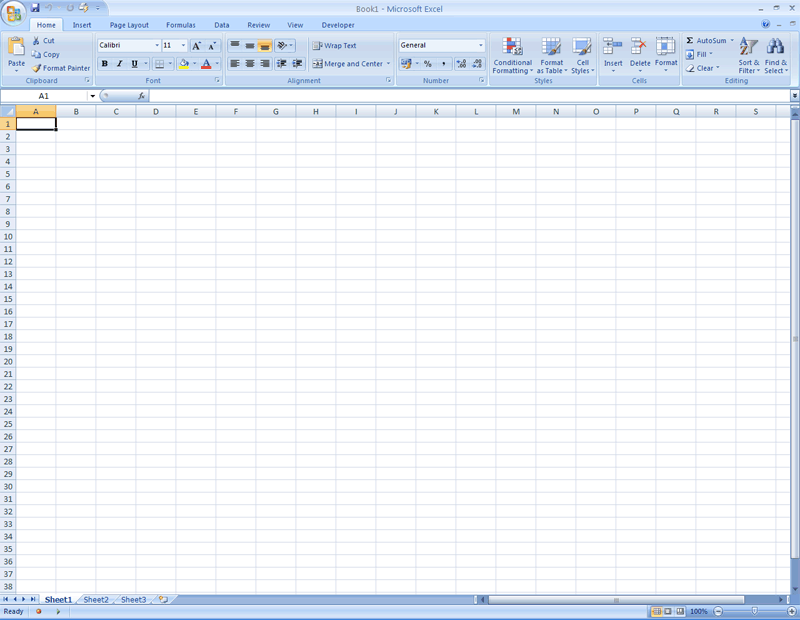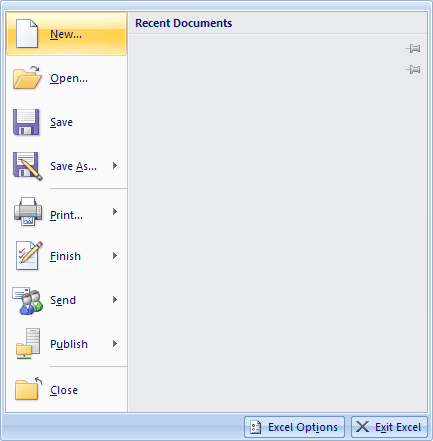A first look at Excel - Microsoft Excel 2007
Microsoft Excel 2007
A first look at Excel
In the first part of our Excel tutorials, we'll explain what you will see when the programme first starts. We're not going to explain what a spreadsheet is, and assume that you already know. If you don't, we have an introduction here:
What is a Spreadsheet?
In this section of the course, you're going to learn what spreadsheets are, and what they can do. You'll get a first glimpse of the Microsoft Excel software, and how it works. You'll also learn about cell coordinates, rows and columns, and how to enter data into a cell. So, let's make a start.
Excel Spreadsheets
A spreadsheet is a piece of software for handling and manipulating numbers. You can write numbers down on a piece of paper and add them up. Like this:
23
12
10
45 =
But that's not a spreadsheet. However, if you bought Microsoft Excel and entered the same numbers into the software, you'd have a spreadsheet. The best part about a spreadsheet is - you don't have to do any adding up yourself! The programme will add the numbers up for you.
A spreadsheet doesn't only add up, of course. It can do a whole lot more besides simple arithmetic. It can handle financial calculations, statistical information, and do complex trigonometry. And it can make a pretty graph for you.
At it's heart, though, a spreadsheet is just a glorified calculator. The main point of using a spreadsheet is do some number crunching. The software will puzzle out the answers to sums for you, and save you a lot of time and effort carrying sevens and trying to remember what eight multiplied by six is.
Why do I need a Spreadsheet?
There are many reasons why you might need a spreadsheet. Here are few different scenarios:
Scenario 1 - Personal Investments
You have bought shares in a few different companies and want to keep track of how well, or badly, they are doing. You could enter these values in a spreadsheet:
MyShare: Share1
Price Paid: 0.25
Number Held: 1000
Total Cost: £250
Value Now: 0.35
Worth Now: £350
Profit/Loss: +£100
The spreadsheet would do all the sums for you. All you have to do is enter the correct formulas. In the spreadsheet above, if we changed the number in the "Value Now" box, the "Worth Now" box and the "Profit/Loss" box will automatically be updated. That way you could see at a glance how well your shares are doing.
Scenario 2 - Personal Finances
We only have a limited amount of money coming into the house each month. The problem is, that money seems to be disappearing pretty fast. If would be nice if we could keep track of where it's all going. A spreadsheet could help us. We could enter the data like this:
Monthly Income: £1500
Gas: 25
Electricity: 20
Phone: 35
HP: 250
Food: 350
Mortgage: 425
Car: 130
Total: £1235
Leftover: £265
Of course, we could do all that on a piece of paper. But entering the data into a spreadsheet gives us better control. We could change one value, that massive food bill, and see how much we had left over if we didn't spend so much money on food. Once the formulas are entered, the other figures would be updated automatically.
So there we have two simple scenarios where a spreadsheet might come in handy. Of course, they can be used, and often are, in a business situation. If you want to keep track of things like stock and profit margins, then spreadsheets are very useful indeed. In fact, spreadsheets are useful in a wide range of situations, both business and non-business.
We'll now move on, and get our first glimpse of Microsoft Excel.
Launch your Excel software. When the programme starts, you'll see something like this in Excel 2007:

To create a new spreadsheet in Excel 2013, click one of the templates. For this course, we'll be using the Blank Workbook temple. Click on that option from the list available. You'll be taken to the main spreadsheet area.
If you've ever used a previous version of Excel then you'll notice that the new version looks quite different! Even if you have never used Excel, the software looks quite intimidating. But we'll make a gentle start, so that you can get used to the way everything works.
The first thing to notice is the Ribbon running right across the top. The Ribbon is supposed to be more intuitive than drop-down menus. Emphasis is placed on the tools and options appropriate to what you're doing. Here's a closer look at the Ribbon when Excel first starts (it's split in half, here):
 |
| Left Side of the Ribbon in Excel 2007 |
 |
| Right Side of the Ribbon in Excel 2007 |
Notice that in both versions the Home tab is the one that is selected. Other tabs are: Insert, Page Layout, Formulas, Data, Review and View. (In the image above, there's also a Developer tab. If you don't do any programming then you don't have to worry about this tab.)
In the top left of the Ribbon in Excel 2007 there's a big circle. This one:

Click this, and you'll see all the file operations: New, Open, Save, Exit, etc.

Labels:
Excel 2007



No comments:
Post a Comment